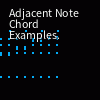03-24-2017, 08:01 AM
I will add screenshots later, wherever there is a number is a placeholder where a screenshot should be. Also if you're coming from the tutorial, you have to have basic prior knowledge on chords to fully understand this... which I will write about eventually.
So a handful of people have asked me why I place two notes that are directly beside each other in the keyboard, such as F# and G in the same chord.
This is a very terrible excuse, but literally it's because it is only so natural for me to do it.
Whenever a chord just feels empty in a certain area, or if I just innately know whether it needs an adjacent note or not, I happen to play around with the chord until I hear it best fit. Usually I add an adjacent note right before the base note, in which this case, in accordance to the screenshot above, F#4 is directly below G4.
This creates an inversion of the Major Seventh (M7) chord, and is probably one of the most versatile configuration of the half-step chords. I cannot name how many times this chord revives the progression of my sequence because it is a clever way of changing the overall tone of the narrative embedded within the track.
More often than not when people are using the M7 chord, they will either omit the base note or use the major seventh as the dominant note instead.
There's nothing wrong with these configurations of M7, but that kinda ruins the point of me writing about this article.
The M7 chord omitting the base note sounds too empty.
The M7 chord using the major seventh as the highest note drags too much attention.
In the case that neither of the two work above, this is the situation where you use the full M7 inversion, the one with adjacent notes.
The M7 inversion is probably one of the best chords to add a subtle dissonance without bringing too much unneeded focus.
Of course, it is also a situational type of chord. You can't just throw it into everything and still expect the sequence to sound greater than before.
You have to keep this kind of configuration fresh, or potentially risk the listener's interest in the sequence.
[url= ]Here is a sequence with examples of other adjacent note chords.[/url] Some chords sound better slurred, so I added a second example for the same chord added with a dominant major seventh. The chords in order are GM7, Gm(add9)/minor 2nd, G(b5), and G+.
]Here is a sequence with examples of other adjacent note chords.[/url] Some chords sound better slurred, so I added a second example for the same chord added with a dominant major seventh. The chords in order are GM7, Gm(add9)/minor 2nd, G(b5), and G+.
So a handful of people have asked me why I place two notes that are directly beside each other in the keyboard, such as F# and G in the same chord.
[1] - G3, F#4, G4, B4, D5
This is a very terrible excuse, but literally it's because it is only so natural for me to do it.
Whenever a chord just feels empty in a certain area, or if I just innately know whether it needs an adjacent note or not, I happen to play around with the chord until I hear it best fit. Usually I add an adjacent note right before the base note, in which this case, in accordance to the screenshot above, F#4 is directly below G4.
This creates an inversion of the Major Seventh (M7) chord, and is probably one of the most versatile configuration of the half-step chords. I cannot name how many times this chord revives the progression of my sequence because it is a clever way of changing the overall tone of the narrative embedded within the track.
More often than not when people are using the M7 chord, they will either omit the base note or use the major seventh as the dominant note instead.
[2] - G3, F#4, B4, D5
G3, G4, B4, D5, F#5
There's nothing wrong with these configurations of M7, but that kinda ruins the point of me writing about this article.
The M7 chord omitting the base note sounds too empty.
The M7 chord using the major seventh as the highest note drags too much attention.
In the case that neither of the two work above, this is the situation where you use the full M7 inversion, the one with adjacent notes.
The M7 inversion is probably one of the best chords to add a subtle dissonance without bringing too much unneeded focus.
Of course, it is also a situational type of chord. You can't just throw it into everything and still expect the sequence to sound greater than before.
You have to keep this kind of configuration fresh, or potentially risk the listener's interest in the sequence.
[url=